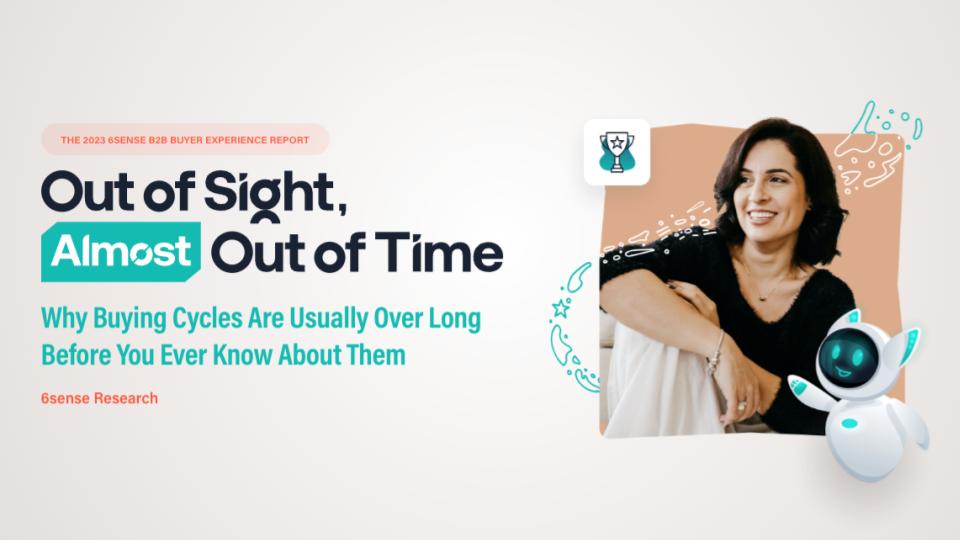“For every complex problem there is an answer that is clear, simple, and wrong”. — H. L. Mencken
The “double funnel” — much in the mouths and blogs of B2Bers lately — is one such answer. In a moment, I’ll get into why it is wrong. I’ll start, however, by surveying why it might seem right.
What Is the Double Funnel, and Why Does It Seem Right?
The double funnel purports to be a method for tracking progress in both Account-Based Marketing (ABM) models, as well as in more traditional demand generation Marketing Qualified Lead (MQL) models.
Over the past decade, more and more companies have transitioned some of their pipeline and revenue generation processes to the ABM model — but most B2B organizations still use both lead-based and account-based practices.
What’s more, the lead-based approach still accounts for the majority of revenue for most organizations that I observed in my time as a Forrester analyst and in the past year at 6sense.
Because most organizations have both lead- and account-based practices, it seems to make intuitive sense to keep the MQL-based funnel — the mechanism for measuring progress — in place, while adding a new funnel specifically for the new ABM model.
Now if you didn’t know anything else about modern marketing, this might sound like a solid approach. It isn’t.
But before diving into why the double funnel is really not the way to go, let’s look at its purported benefits. The idea of the double funnel is to have two pathways for opportunities to get to sales:
- The MQL pathway, and
- The ABM (or marketing qualified account) pathway
The Gartner double funnel. Accessed 06-25-22.
Another perceived benefit is that it limits the scope of transformation that true account-based practices require.
It’s not a trivial effort to shift from MQL-based demand generation to account-centric demand generation — particularly with respect to measuring success. Transforming on a small scale while retaining the old familiar feels safer. You’re not completely abandoning everything you know and marching out into this brave new world completely. You’re hedging your bets.
Why the Double Funnel is Half-Baked
However, none of these benefits address the problem with lead-based processes to begin with. And that is, they suck. They don’t work.
The failure rate is in the vicinity of 99%, and nothing anyone has ever done has improved it much.
Trust me, my friends and I at SiriusDecisions poured years of effort into hundreds of demand-gen teams working to improve MQL conversion outcomes. You can make improvements of 3% to 5% or thereabouts to conversion rates in the very worst-run operations, and you can goose a 1% or 1.5% improvement out of the rest, but that’s about it.
There’s a reason everything you see from Forrester these days is about buying groups and opportunities. That’s because at the heart of why MQLs suck is that MQL-based models like the double funnel ignore the single most important fact of B2B buying, which is that B2B buying is done by groups of people working together.
To put it plainly, your buyer is almost certainly a group of people, and for most B2Bers, that group is in the double figures. They all conduct research — even those at the top of the ladder — and they all leave “digital footprints” across the internet as they conduct that research.
Here’s the rub: If you continue to orient your non-ABM processes around the MQL, you’ll continue to miss nearly all of the important buying signals on offer. Further, you’re condemning that part of your strategy for generating revenue to mediocrity — at best.
The signals your sellers won’t see (signals that reside in what we call the Dark Funnel™) are critical for virtually all B2B buying and selling processes. This applies to mid-market, commercial, enterprise, strategic, named — however your audience segments are organized.
If the buying team is more than a couple people (and for 90% of you, it is), then you need all the signals. The MQL alone will drive misalignment and weaker-than-need-be performance.
What my former colleagues at SiriusDecisions/Forrester realized is that you can be less awful at lead conversion. You can’t be good at it without identifying which MQLs are associated with active buying groups.
And there’s simply no way to tell which MQL is part of an active buying process simply by looking at the MQL. If your buyer is more than two people — and that’s virtually everyone who would read this — then the new job of marketing is to:
- Attract and engage as many members of the buying group as possible
- Use the interaction data to identify and prioritize true buying teams for sellers
- Focus on the account level rather than individual content consumers
There’s nothing special about an MQL. It may be that the only thing that distinguishes an MQL from a pre-MQL is how much time the MQL had at his or her disposal to consume content.
So unless you sell deals where there’s only one or two people involved, the most important thing you can do is notice when you have more than one lead or unique visitor to your website (or event) from the same organization.
If you have two leads that are not yet MQLs from one organization, and one MQL from another organization, please please please (pardon the Morrissey reference but feel free to read it as sung) prioritize the former ahead of the latter. If you’re running the MQL funnel or waterfall, you’ll never see it happening.
And you absolutely should do everything in your legal power to know which accounts are on your website anonymously, as well. Nearly all of your web traffic is anonymous — maybe 96% or so. A healthy portion of that hails from accounts that are shopping you. Ignoring that at this point is malpractice.
If you run a double funnel, with most of your business going through the MQL funnel, you’ll still fail to capitalize on nearly all of the signals that are available to you.
At the very least, you have three layers of evidence about which accounts are in-market for your solutions:
- You have people who filled out forms or attended events
- You have anonymous traffic that you can de-anonymize to accounts, and
- You have third-party intent
The more of each of these layers you can bring to bear on prioritizing opportunities for sales, the better you’ll do.
Wrapping Up
So, to recap, if some of your revenue comes from very small deals with one- or two-person buying committees, go for the double funnel.
But if you’re tempted to do the double funnel because your ABM practice is just part of your business and you want to stick with the old familiar, I beg you not to. If you’re still running a leads-based funnel for part of your pipeline production a couple years from now, you’re going to find it impossible to compete.
Also, 6sense can simply do it for you.







